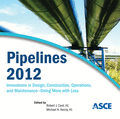Condition Assessment of a Ductile Iron Force Main Using Guided Wave Technology: Case Study of Underwood Creek Force Main, Milwaukee Metropolitan Sewerage District
Publication: Pipelines 2012: Innovations in Design, Construction, Operations, and Maintenance, Doing More with Less
Abstract
This paper presents the development of an inspection plan and the application of various technologies to conduct the testing on a 36-inch ductile iron sewer force main pipe. Following two failures in the past four years on the Underwood Creek Force Main, the Milwaukee Metropolitan Sewerage District conducted a condition assessment of the 36-inch ductile iron pipeline. The pipeline is 9,950 feet long and runs adjacent to Underwood Creek in the City of Wauwatosa for about 6,000 feet and then down the middle of Water Town Plank Road, a major roadway. The first phase of the work included the evaluation of various inspection technologies and procedures to identify the most cost effective method to determine the condition of the pipe. The results of the study identified a combination of corrosion potential evaluations using close interval potential survey (CIPS), soil characteristics, guided wave, ultrasonic tests and visual inspection. The CIPS and soil characteristics were used to identify 10 locations to excavate the pipe and conduct additional testing. The use of ultrasonic guided wave technology (GWT) has become increasingly popular over the years for use in screening steel piping systems for degradation due to the ability of GWT to screen long lengths of pipe from a single accessible location. GWT assessments require the placement of a guided wave transducer collar at a fixed axial position along the pipe. The transducers are then software/hardware controlled to introduce ultrasonic guided waves which travel axially along the pipe. When the guided waves encounter changes in the cross-section or stiffness of the pipe, reflections occur which propagate back to the transducer collar where they can be received and processed to identify areas of potential degradation for additional investigation. GWT has been applied primarily to carbon steel piping systems with comparatively much less testing having been conducted on ductile iron piping systems. GWT results obtained on the Underwood Creek Main show promise for applying the technology to such systems as good signal to noise ratios have been achieved when considering responses from known pipeline features. During testing of the force main, GWT examinations were conducted inside eight different excavations to screen approximately 319 total feet of pipe. This paper discusses the challenges associated with implementing the inspection plan and the results of the inspections including those obtained by using the GWT on the ductile iron pipe.
Get full access to this article
View all available purchase options and get full access to this chapter.
Information & Authors
Information
Published In
Copyright
© 2012 American Society of Civil Engineers.
History
Published online: Nov 9, 2012
ASCE Technical Topics:
- Case studies
- Cast iron
- Engineering fundamentals
- Engineering materials (by type)
- Infrastructure
- Iron (material)
- Lifeline systems
- Materials engineering
- Metals (material)
- Methodology (by type)
- Pipeline systems
- Pipes
- Pressure pipes
- Research methods (by type)
- River engineering
- Rivers and streams
- Sewers
- Urban and regional development
- Urban areas
- Water and water resources
Authors
Metrics & Citations
Metrics
Citations
Download citation
If you have the appropriate software installed, you can download article citation data to the citation manager of your choice. Simply select your manager software from the list below and click Download.
